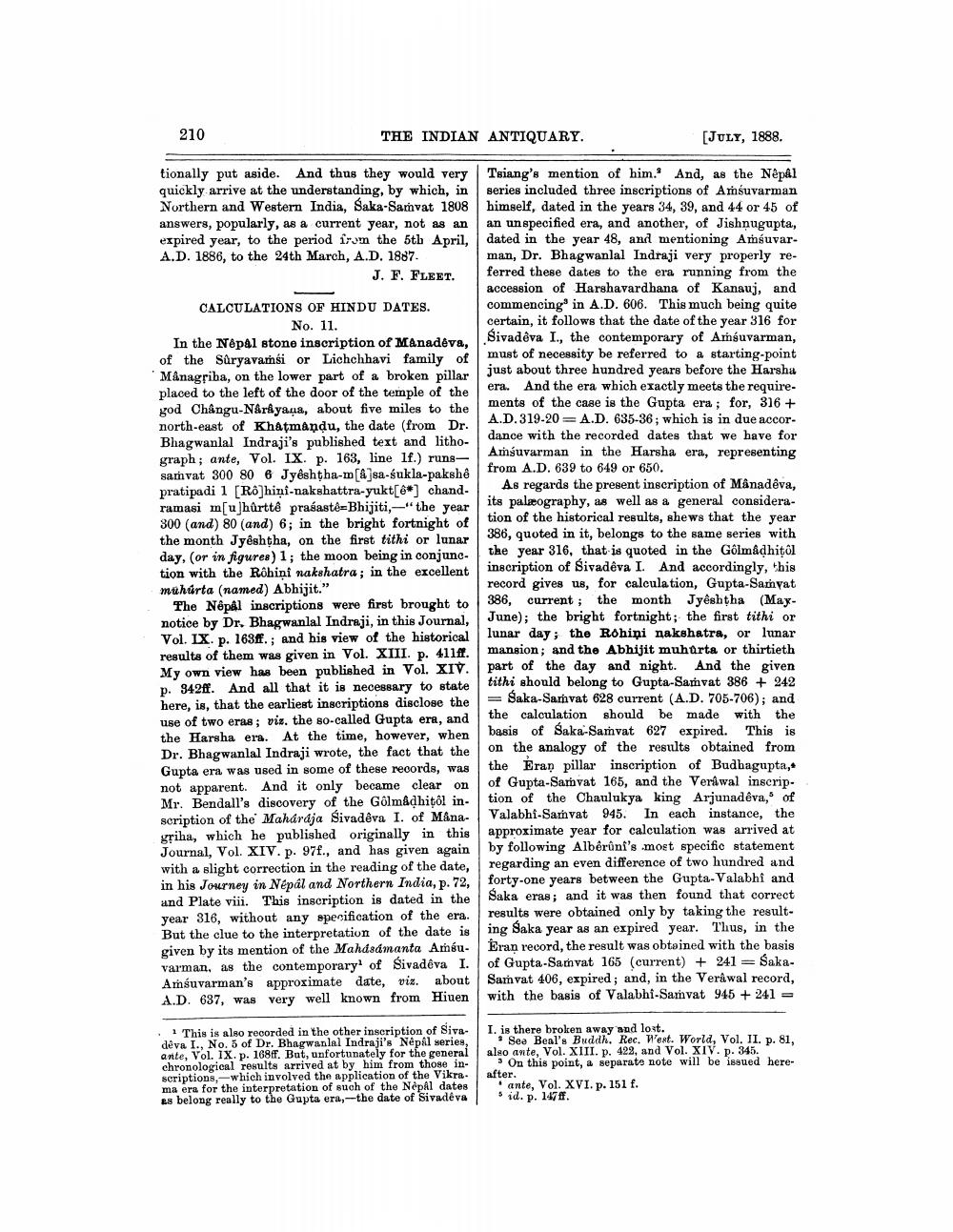________________
210
THE INDIAN ANTIQUARY.
[JULY, 1888.
tionally put aside. And thus they would very quickly arrive at the understanding, by which, in Northern and Western India, Saka-Samvat 1808 answers, popularly, as a current year, not as an expired year, to the period iron the 5th April, A.D. 1886, to the 24th March, A.D. 1887.
J. F. FLEET.
CALCULATIONS OF HINDU DATES.
No. 11. In the Nepal stone inscription of Manadeva, of the Saryavamsi or Lichchhavi family of Månagriba, on the lower part of a broken pillar placed to the left of the door of the temple of the god Chángu-Narayana, about five miles to the north-east of Khatmandu, the date (from Dr. Bhagwanlal Indraji's published text and lithograph; ante, Vol. IX. p. 163, line 1f.) runssamvat 300 80 6 Jyêshtha-m [A]sa-sukla-pakshe pratipadi 1 [R6]hini-nakshattra-yukt[6] chandramasi m[ujhürttê prasastê=Bhijiti, -"the year 800 (and) 80 (and) 6; in the bright fortnight of the month Jyêshtha, on the first tithi or lunar day, (or in figures) 1; the moon being in conjunction with the Rõhiņi nakshatra; in the excellent muhúrta (named) Abhijit."
The Népal inscriptions were first brought to notice by Dr. Bhagwanlal Indraji, in this Journal, Vol. IX. p. 1638.; and his view of the historical results of them was given in Vol. XIII. p. 4118. My own view has been published in Vol. XIV.
en published in Vol. XIV. p. 342. And all that it is necessary to state here, is, that the earliest inscriptions disclose the use of two eras; vix, the so-called Gupta era, and the Harsha era. At the time, however, when Dr. Bhagwanlal Indraji wrote, the fact that the Gupta era was used in some of these records, was not apparent. And it only became clear on Mr. Bendall's discovery of the Golmadhitol in- scription of the Mahardja Sivadêva I. of Måna- priha, which he published originally in this Journal, Vol. XIV. p. 97£., and has given again with a slight correction in the reading of the date, in his Journey in Nepal and Northern India, p. 72, und Plate viii. This inscription is dated in the year 316, without any specification of the era. But the clue to the interpretation of the date is given by its mention of the Mahdsamanta Ambuvarman, as the contemporary of Sivadêva I. Amsuvarman's approximate date, viz. about A.D. 637, was very well known from Hiuen
Tsiang's mention of him.' And, as the Nepal series included three inscriptions of Amsuvarman himself, dated in the years 34, 39, and 44 or 45 of an unspecified era, and another, of Jishnugupta, dated in the year 48, and mentioning Amsuvarman, Dr. Bhagwanlal Indraji very properly referred these dates to the era running from the accession of Harshavardhana of Kanauj, and commencing in A.D. 606. This much being quite certain, it follows that the date of the year 316 for Sivadôva I., the contemporary of Amsuvarman, must of necessity be referred to a starting point just about three hundred years before the Harsha era. And the era which exactly meets the requiremente of the case is the Gupta era; for, 316 + A.D. 319-20= A.D. 635-36; which is in due accordance with the recorded dates that we have for Amsuvarman in the Harsha era, representing from A.D. 639 to 649 or 650.
As regards the present inscription of Manadêva, its palaeography, as well as a general consideration of the historical results, shews that the year 386, quoted in it, belongs to the same series with the year 316, that is quoted in the Golmadhitól inscription of Sivadêva I. And accordingly, this record gives us, for calculation, Gupta-Sarnyat 386, current; the month Jyêshtha (May. June); the bright fortnight; the first tithi or lunar day; the Rohini nakshatra, or lunar mansion; and the Abhijit muhurta or thirtieth part of the day and night. And the given tithi should belong to Gupta-Samvat 386 + 242 = Saka-Samvat 628 current (A.D. 705-706); and the calculation should be made with the basis of Saka-Samvat 627 expired. This is on the analogy of the results obtained from the Eran pillar inscription of Budbagupta. of Gupta-Samvat 165, and the Verawal inscription of the Chaulukya king Arjunadêva, of Valabhi-Samvat 945. In each instance, the approximate year for calculation was arrived at by following Albêrûni's moet specific statement regarding an even difference of two hundred and forty-one years between the Gupta- Valabhi and Saka eras; and it was then found that correct results were obtained only by taking the result. ing Saka year as an expired year. Thus, in the Eran record, the result was obtained with the basis of Gupta-Samvat 165 (current) + 241 SakaSarvat 406, expired; and, in the Veråwal record, with the basis of Valabhi-Samvat 945 + 241 -
This is also recorded in the other inscription of Siva- deva I., No. 5 of Dr. Bhagwanlal Indraji's Népal series, ante, Vol. IX. p. 168F. But, unfortunately for the general chronological results arrived at by him from those inscriptions, which involved the application of the Vikra. ma era for the interpretation of such of the Nepal dates es belong really to the Gupta era,--the date of Sivadéva
I. is there broken away and lost.
See Beal's Buddh. Rec. West. World, Vol. II. p. 81, also ante, Vol. XIII. p. 422, and Vol. XIV. p. 345.
On this point, a separate note will be issued hereafter.
ante, Vol. XVI. p. 151 f. s id. p. 14788.




